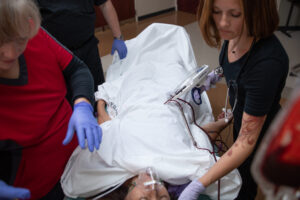
Each year, over 780,000 adults in the United States experience acute coronary syndrome (ACS). Of those, approximately 70% have non-ST-segment elevation myocardial infarction (NSTEMI).1 Causes of NSTEMI vary, but risk factors include high blood pressure and cholesterol, diabetes, obesity, family history, sedentary lifestyle, and tobacco use.
In treating patients with NSTEMI, interventions often focus on preventing and minimizing ischemic complications.2 This involves the use of antithrombic medications and minimally invasive intervention in the catheterization lab (cath lab). Unfortunately, these interventions also increase the risk of severe bleeding—often requiring emergent blood volume replacement. As many as 10% of patients hospitalized with myocardial infarction (MI) receive a blood transfusion during their stay.3
In these hemorrhage cases where time is of the essence and treatment delays can be the difference between life and death, there is no time to waste. Traditional methods of rapid blood transfusion, such as pressure bags, rapid infusers, and the “push-pull” method, often introduce delays in care, require additional time to set up, or demand specialized training from providers.
The following case from a large California hospital outlines the positive impact of using a novel handheld rapid infuser to quickly administer blood products to a patient experiencing hemorrhage post-NSTEMI.
Case Presentation & Challenges
A 50-60 year old patient arrived at the hospital with a chief complaint of NSTEMI. Soon after arrival, the patient was taken to the cath lab for intervention. While in the cath lab, the patient became pale and unresponsive. An assessment of patient vitals, including systolic blood pressure (SBP) which had fallen into the 60s, indicated hypovolemic shock. The patient was also actively bleeding at this time. The patient’s medical history prior to this event was unknown at the time of treatment.
Management
Recognizing the danger of a decompensating patient with bleeding and shock, blood product transfusions were immediately ordered. Intravenous access consisted of an 18G catheter in the right arm. Using the LifeFlow PLUS rapid infuser, the nurses administered a total of six units of packed red blood cells (PRBCs) (300mL each) and one unit of fresh frozen plasma (FFP). The patient was reassessed following each unit of blood products, each taking less than two minutes to administer. The patient’s vital signs, including HR and BP, improved after the administration of each unit of blood product, ultimately returning to stable levels.
Discussion
Patients with hemorrhage and shock require immediate intervention, often including rapid blood administration. For a highly trained user, traditional rapid infusers can be fast, but they are large and expensive and therefore typically limited to the OR and trauma bay. There are many areas of the hospital, including the cath lab, the ICU and often the ER, where an easy-to-use, portable rapid infuser would be beneficial. LifeFlow PLUS is a handheld rapid infuser designed for use by any clinician, experienced or new, throughout the continuum of care.
In this case, the patient begin decompensating in the cath lab and the clinicians ordered immediate blood transfusion with LifeFlow PLUS. The patient responded well and ultimately stabilized. The providers noted that LifeFlow worked well and the set-up process was quick and easy. The team also highlighted the device’s simplicity and the ability to more rapidly administer a unit of blood, reassess the patient and then administer another unit (or more) as needed.
In cases where blood volume must be replaced quickly, traditional methods can cause critical delays in patient care. The LifeFlow device is easy to use and can be operated efficiently to rapidly administer multiple units of blood products anywhere in the hospital when time is of the essence and every minute matters.
- Basit H, Malik A, Huecker MR. Non ST Segment Elevation Myocardial Infarction. [Updated 2023 Feb 8]. In: StatPearls [Internet]. Treasure Island (FL): StatPearls Publishing; 2023 Jan-. Available from: https://www.ncbi.nlm.nih.gov/books/NBK513228/
- Subherwal, S., Bach, R. G., Chen, A. Y., Gage, B. F., Rao, S. V., Newby, L. K., Wang, T. Y., Gibler, W. B., Ohman, E. M., Roe, M. T., Pollack, C. V., Jr, Peterson, E. D., & Alexander, K. P. (2009). Baseline risk of major bleeding in non-ST-segment-elevation myocardial infarction: the CRUSADE (Can Rapid risk stratification of Unstable angina patients Suppress ADverse outcomes with Early implementation of the ACC/AHA Guidelines) Bleeding Score. Circulation, 119(14), 1873–1882. https://doi.org/10.1161/CIRCULATIONAHA.108.828541
- Sherwood, M. W., & Rao, S. V. (2013). Acute coronary syndromes: Blood transfusion in patients with acute MI and anaemia. Nature reviews. Cardiology, 10(4), 186–187. https://doi.org/10.1038/nrcardio.2013.14

